mobile View, to the German Version tap the flag


- Islamic Republic of Mauritania
- presidial republic
- own names:
Arabic: Al-Jumhuriya al-Islamiya al Muritaniya
French: République Islamique de Mauritanie
• Flag
• Historical Flags
• Meaning/Origin of the Flag
• Coat of Arms
• Meaning/Origin of the Coat of Arms
• Aircraft Roundel
• Map
• Numbers and Facts
• History
• Origin of the Country's Name
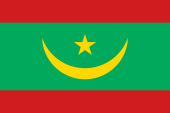
since 2017,
National flag,
ratio = 2:3,
Source, by: Wikipedia (EN)






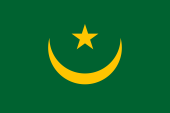
1959–2017,
National flag,
ratio = 2:3,
Source, by: Wikipedia (EN)





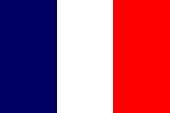
1903–1959,
Flag of France,
ratio = 2:3,
Source, by: Corel Draw 4






The today's flag of Mauritania was introduced on 6th of August in 2017. It is green with two more narrow red stripes up and down and shows in the center of the green surface half-moon and star in yellow. The points of the half-moon point upward. The red stripes were added to the flag to give the appearance of the flag a more African look. The color green also stands for Islam, red for sacrifice and yellow is the color of the sand. The colours of the flag seem to be defined today as follows, in hexadecimal: green = #00A95C, which would correspond to Pantone Hexachrome Green, red = #D01C1F, which would correspond to Pantone 1795 and yellow = #FFD700, which would correspond to Pantone 109. The combination of the colours green, yellow and red in the today's flag are the Pan-African colours: Perhaps in 1900 was the beginning of the Panafrica-Movement, wich wants to emphasize the commons of all people with black skin. For the political unity of Africa stands the colour-triad green-yellow-red, wich used many african countries in their flags after the independence. The first country was Ghana in 1957. As the origin apply the colours of Ethiopia (Abessinia), the oldest independent state in Africa. The first flag of Mauritania was introduced on 1st of April in 1959. It showed a single-coloured green bunting with the islamic symbolism of half-moon and star in yellow. The points of the half-moon pointed upward. The green stood for prosperity and for the hope for a better future. Yellow is not only the colour of the sand in the desert, but it stands for the mineral ressources of the country too. The islamic symbolism, with thw half-moon and the star, is from Ottoman origin. The last Calif (from the house of the Abbaside's) was executed in 1258. The Calif – successor of Mohammed – was the religious and worldly head of the "Islamic Empire". About 1460 the Califate was revitalized by the ruler of the Ottoman Empire. This function became more important as the Turks conquered Mecca Town in 1517, as they became the supreme protectors and preservers of the holy places. The control over the holy places got lost during the First World War (Mecca 1916, Medina 1918). In 1924 the Califate became abolished by the Turkish national congregation. In this way became half-moon and star spreaded in the whole world as the Symbols of Islam. The coupling of that symbols with green flags has its roots in the ottoman panislamism. As there arised independence movements in some regions of the Ottoman Empire, encounts Abdul Hamid II. these movements successful with the unifying string of panislamism. To the symbol of the panislamism he made the green flag (colour of the overcoat of the Prophet Mohammed), and layed above the Turkish coat of arms. The flag of the Islam was created.
Source:
Flaggen Wappen Hymnen,
Die Welt der Flaggen,
Flaggen und Coat of arms of the Welt,
Wikipedia (EN),
Volker Preuß

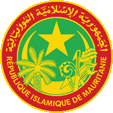
since 2017,
Seal of Mauritania,
Source: Jelloud Najem, Public domain, via Wikimedia Commons
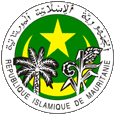
1960–2017,
Seal of Mauritania,
Source: Corel Draw 4

Mauritania uses – like many former French colonies – a seal as coat of arms. It was introduced on the 3rd of August in 1960. On 17th of August in 2017, the coat of arms - like the flag - was modified in colour. The border of the seal was dyed red and it was paid attention to the use of the only colours red, yellow and green. The seal shows in the middle in the background on a green disk the subject of the flag: half-moon and star. In the foreground a date-palm tree and millet plants. The inscription around the seal shows in Arabic and French language the name of the country. There are single-coloured versions of the seal too, in which green turns to black and yellow turns to white, respectively is the whole background of the coat of arms black and the yellow and the inscription are white. The rare used reverse of the coat of arms shows between palm fronds and olive twigs in Arabic and French language the motto of the country: "honor, brotherhood, justice"
Source:
Flaggen Wappen Hymnen,
Flaggen und Wappen,
Flaggen und Coat of arms of the Welt

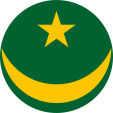
Aircraft Roundel,
Source, by: Wikipedia (EN)

Location:
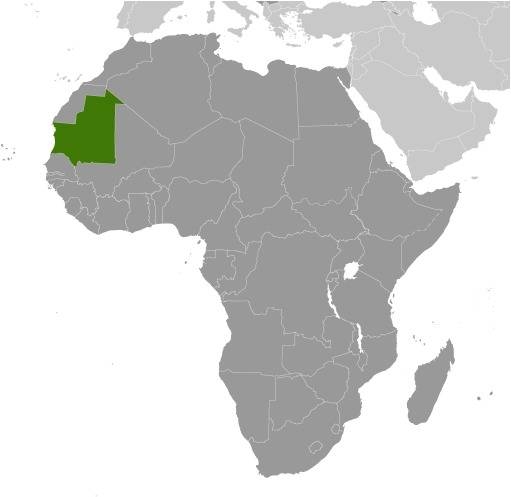
Source: CIA World Factbook
Map of the country:
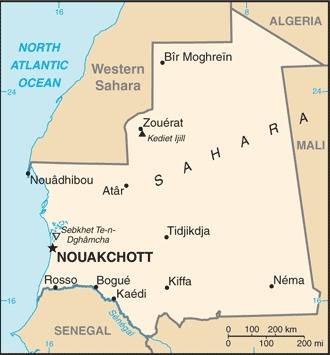
Source: CIA World Factbook

Area: 397.954 square miles
Inhabitants: 4.600.000 inh. (2020), 40% Haratin (Moors + Black Africans), 30% Mauren (Arabs + Berbers), 30% Wolof, Tukolor, Soninke
Religions: 99% Muslim
Density of Population: 12 inh./sq.mi.
Capital: Nouakchott, 1.116.700 inh. (2017)
official Language: Arabic
other Languages: French, Wolof, Tukolor, Soninke
Currency: 1 Ouguiya (MRU, UM) = 5 Khoums
Time Zone: GMT
Source:
Wikipedia (D),
CIA World Factbook

1076 · the Moroccan Almorawide's dynasty conquers the Empire of Ghana (today's Southern Mali and Southern Mauritania) and establishes an Empire (today's Spain, Morocco, West Sahara, Mauritania), Islamization and later as well Arabization of the today's Mauritania, specially in the north of the today's Mauritania recognize the tribes of the Shengit the supremacy of Morocco until the into the modern era
1902–1910 · conquest of the desert area by French troops
1903 · establishment of the French protectorate
1920 · annexation to French West Africa
1946 · Mauritania becomes a French overseas province
28th of November 1958 · autonomy
28th of November 1960 · France grants independence to Mauritania → Morocco recognizes Mauritania initially not, makes territorial claims and keeps no diplomatical relationships to Mauritania
1964 · single-party-system
1966 · race riots
1970 · start of diplomatical relationships to Morocco
1974 · nationalization of the mining industry (iron ore)
1975 · Spain disclaims for its rights in West Sahara, the right of sovereignity of West Sahara becomes internationally recognized, Morocco and Mauritania invade West Sahara
1976 · Morocco and Mauritania partition West Sahara among themselves
1978 · military coup
1979 · Mauritania gives up its part of West Sahara for the West Sahara Liberation Front "POLISARIO", Morocco annexes this area too
1984 · coup d'état
1989 · in result of race riots conflicts with Senegal
1991 · new constitution, multi-party-system
1992 · elections for president and parliament
1999 · conflicts with Mali
2005 · military coup
2006 · elections
2008 · military coup
2009 · elections
2014 · military coup
Source:
Atlas zur Geschichte,
Weltgeschichte,
Wikipedia (D)

The name "Mauritania" has its roots in the Moors, the Berberic native population of the Maghreb. Already in the antiquity was in use the name "Mauritania" for the today's Morocco. Nowadays are named as Moors the Islamic Berberic-Arabic mixed population of the Maghreb. The word "Moors" probably has its origin in the Phoenician word for "dark".
Source:
Volker Preuß,
Handbuch der geographischen Namen


![]()















